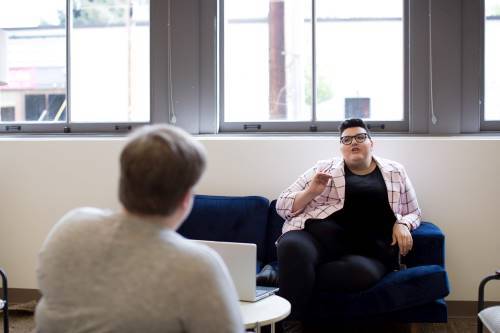Top tips for overcoming challenges in lived experience work
In lived experience work, it's common to feel unsure how to do things, or to be worried about something. But even if you have concerns, don't shy away from involving people in your project. Influence and participation work can be tricky, but by seeking advice and asking questions, you can often overcome your challenges.
Sarah-Jane and Charlotte's experiences
In this video, Sarah-Jane and Charlotte from Mind discuss some of the challenges with lived experience work. They talk about working in a new place, how to evaluate your work, and making reasonable adjustments.
Top tips for overcoming challenges from Sheffield User Survivor Trainers
Sheffield User Survivor Trainers (SUST) is a network of mental health trainers with lived experience of mental health problems. Here are their top tips for a successful project:
- Before you start the project, make sure you’re fully committed to the principles of influence and participation.
- Recognise that people with lived experience may have skills and experiences that staff won't.
- Recognise the skills people have and what they can offer, rather than what they can’t.
- Be clear about the activities people can be involved in, and be specific about how much they can influence.
- Focus on the outcomes you want to achieve, and minimise any activity that doesn’t work towards them.
- People should get something back for the time they put in. That could be payment, training, or a reference. Be clear about what they'll get from the start.
- Make sure you share the workload fairly throughout the project.
- Don't forget to monitor and evaluate the project, to see how well it's meeting its goals.
Top tips from the Qur’an and emotional health project
We set up this project to learn how to engage more effectively with people from Muslim communities. We wanted to learn how we could meet their needs in culturally appropriate ways.
We gathered these tips from the project and its feedback:
- Don’t be afraid to step out of your comfort zone.
- Challenge your assumptions by asking questions and listening to people’s responses.
- Keep in mind the community’s needs and work towards them – not your own.
- Don’t be scared of getting things wrong. If you make sure the people you’re working with know you’re there for them, you can gain their trust and they’ll be understanding and supportive.
- Be clear about what you can offer and agree on common objectives.
- Develop links with community-based organisations and community leaders. Creating strong, reciprocal relationships will help you to ask for advice and get support from authoritative people. Sometimes you’ll need to ask others to carry out your activity, as they have influence among their communities.
Tips for managing risk in lived experience work
- Think about physical and emotional risks. What can you do to reduce the likelihood of an accident? How can you stop people from being triggered and becoming distressed?
- Think about both staff and the people taking part. Everyone’s safety is important.
- Ask others for their thoughts and opinions. They may think of something you haven't, or see things differently. It can be really helpful to hear other people’s perspectives.
- Fill in our managing risk tool. Share the completed tool with the people running the activity. They need to know what to do if a risky situation happens.
This work is licensed under a Creative Commons Attribution-NonCommercial-NoDerivatives 4.0 International License.











